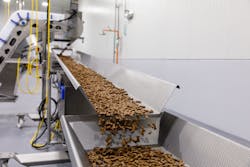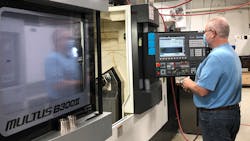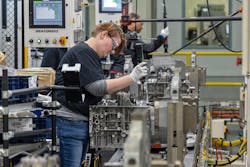Increasingly complex equipment and machinery have turned shop floors into high-tech marvels. Festooned with sensors, dependent on digital, high-cost and hard at work, these production technologies are growing ever more important with large, medium and small manufacturers.
Thankfully, tool producers designed many such sophisticated machines with an eye for easy operation by production associates. But what about when those high-complexity, high-cost pieces of equipment break down? Who will fix them? Between the widely reported shortage of skilled maintenance workers and the increasing sophistication of technology, keeping production assets up and running is an enormous endeavor—and not one easily achieved.
IndustryWeek recently spoke with three manufacturers, large and small, to find out more about their maintenance challenges and to share a few of the tactics they employ to help achieve their uptime goals.
KLN Family Brands: Adding Rigor to Maintenance & Reliability
KLN Family Brands
- Perham, Minnesota
- Family-owned manufacturer of human and pet treats
KLN opened a new Tuffy’s Treat Co. manufacturing plant in Delano, Minnesota, at perhaps the most challenging time possible—December 2020 with COVID still in full swing. Not surprisingly, the new site, which makes pet treats and more recently, wet, canned pet food, immediately struggled to hire qualified employees for production and maintenance roles.
That challenge is ongoing today, particularly in maintenance, and it has prompted action. While multiskilled individuals are KLN’s preferred hires, they also are difficult to find, explains Jeff Nevenhoven, maintenance and reliability manager at the Delano factory. The hiring criteria had to be expanded.
“We had to start thinking differently [as in] ‘How do we get people here that can help us and maybe not have everything we would have liked to have, but who have some very specific skill sets that we can start with and then grow and develop them?’” he says.
The second hire was a shop teacher from the public school system, and he has strengths in basic skilled trades such as welding, pipe fitting and fabricating. He has no automation background. “But we decided we’re going to bring him on board because we have work, we need that skillset. So we’re starting to reach out of our comfort zone and look for these pockets, and build our team that way,” he says.
The company is taking additional steps to meet its maintenance needs: leveraging partnerships with local contractors and vendors; implementing condition-based maintenance methodologies (versus calendar-based) to create more resource capacity by performing maintenance only when conditions show it’s needed; and flexing shift coverage to address staff shortages.
Perhaps the manufacturer’s biggest undertaking, however, is the development of a maintenance and reliability community of practice across the organization. The program is in its infancy, with conversations having kicked off in the third quarter of 2022.
The genesis for developing a community of practice was a desire to move away from the fix-it-when-it-breaks mentality and “establish something that is sustainable, that will extend asset useful life,” Nevenhoven explains. He was hired to add that sensibility to the Delano plant and similar managers were hired at KLN Brands’ two other businesses—Tuffy’s Pet Foods and Kenny’s Candy & Confections.
Coupled with sustainability is desire is to operate as one company rather than three siloed organizations. A recent ERP implementation that has everyone using the same CMMS module is a step in that direction. Still, the organization lacks visibility among the business units, and it’s trying to address that.
“We met recently to take the steps forward… How do we start to leverage the strengths of each organization and make things visible to each other, leverage each other, help each other get common practices?” Nevenhoven says. Ideally, “if I need to find a motor, or a pump, or a gearbox, I have visibility to what’s in their warehouses. Today there’s no visibility of that.”
Hence the beginnings of a maintenance and reliability community of practice. In the recent meeting, the team discussed a framework to:
- Outline what global business processes need to be established so that, regardless of which facility you are in, the work is handled the same way
- Build visibility into resources across sites–people and materials
- Establish a global skill development program that will not only expand technicians’ skillsets and enable sharing of those resources, but which creates alignment among the titles. The qualifications of a Level 1 technician, for example, would be the same across all the sites. The team already is exploring online training opportunities.
“We’re looking at putting that all together to become, in simple words, one company versus three separate ones, so we can actually help each other out better,” Nevenhoven says.
The new Tuffy Treat plant in Delano will also host a pilot program, splitting the maintenance and reliability department into two departments: one focused on maintenance and the other on reliability. Nevenhoven will oversee the reliability department.
The idea, he says, is for maintenance to address day-to-day execution required to keep the plant running, while reliability focuses on establishing predictive maintenance and building out the CMMS and other reliability infrastructure.
Nevenhoven says it’s an atypical practice to see the maintenance and reliability departments split up, “especially within a company this small, but I think there is a lot of promise with it.”
Alloy Precision Technologies: Don’t Forget Software Maintenance
Alloy Precision Technologies
- Mentor, Ohio
- Precision machining and welding
Last year the Alloy Precision Technologies invested 8.5% of its revenue in new capital equipment, and investment routinely ranges from 4% to 8%, fitting the company’s strategic focus of continuous investment in state-of-the-art production equipment. Such expenditures mean that the shop floor is rife with newer production assets.
“As the old commercial said, this isn’t your father’s Oldsmobile anymore,” Canty says. He points to CNC machines as one example, outlining how they have developed dramatically in the past 30, 20 and even five years in terms of the breadth and combination of cuts they can perform.
“And that kind of improvement of technology is spreading across the factory floor in all areas of operations … all of which has to be maintained in some way,” he notes.
Such complexity requires a much higher level of skilled talent on the maintenance side than he says is being produced today. Canty says, “It’s less and less typical that you can go to the market or out of a school and find someone who is very experienced in the modern technologies, or even in the older technologies, so training internally becomes much more critical.”
Reliance on the equipment manufacturers is another important piece to gaining technical expertise.
Canty is equally concerned about maintenance of an integral part of modern technologies that you can’t see—the software—and his company is devoting a lot of attention to that concern. “All of the newer equipment and newer ways of doing things are being driven by [software] programs, so the number of programs and different types of programs on different types of equipment are proliferating on the shop floor,” he says. Moreover, smarter assets are now equipped to supply information about predictive maintenance, equipment utilization and other data points, which requires maintenance as well.
The ever-expanding software-driven technologies in manufacturing have prompted Alloy Precision Technologies to create a two-person, internal IT team, “which is not common for a company of our size of 100 people,” Canty notes. While the primary focus of software maintenance is the shop floor, it extends throughout the organization.
The company has embarked on a journey to systemically capture and document all of its programming and other software-driven tasks so that institutional knowledge isn’t lost if individuals leave the company or retire. Canty estimates Alloy Precision Technologies is about a year away from fully encapsulating a system that is sustainable over time.
“I think far too many companies haven’t understood the need for this going down the road,” Canty says. “Maybe I think it’s a bigger need than it is. I don’t think so.”
Nissan: Why Not Train Everyone?
Nissan Decherd Powertrain Assembly
- Decherd, Tennessee
- Engine and powertrain assembly
- 1.5L 3-cylinder engine
- 2L turbo 4-cylinder engine
- 2.5L 4-cylinder engine
- 3.5L 6-cylinder engine
- 3.8L 6-cylinder engine
- 5.6L 8-cylinder engine
- eMotor assembly
The production floor of an automotive manufacturer teems with every manufacturing technology imaginable. Automotive giants undoubtedly employ a raft of sophisticated technologies and highly skilled maintenance personnel. Still, can you ever have too many people engaged in keeping your high-tech assets up and running?
“We pull technicians off the floor and give them a technical school background education,” explains Tracey Meeks, operator-driven reliability (ODR) training/maintenance supervisor. Meeks was tasked with developing the program about four years ago.
“It’s a video-based learning system,” coupled with hands-on training on the shop floor, he says. “We sit down, and we show them how to use screwdrivers, we show them how to use multimeters, we show how to how to clean, how much grease goes in a bearing, the proper way to route cable and fix loose components on the machine structure.”
Technicians who qualify can then go out onto the production floor and do minimum repairs without the help of maintenance.
While Meeks emphasizes that the word “basic” when he describes ODR skills training, the program has structure around it. Comprised of four levels, topics range from those already mentioned to basic troubleshooting techniques and even a foundational electricity course at Level 4. The latter is a nod to automakers’ move into electric vehicles.
“Not only do [technicians] build electrical products, but they can also understand the very basics of how all those components work together to make our vehicle,” says Meeks.
The philosophy of “train everyone” is working, Meeks says. “Our Nissan maintenance guys are multicraft. Our guys are robot programmers, they are conveyor technologists and computer programmers, they do PLCs,” he explains. And yet, in the past they could be pulled away from highly technical jobs to perform simple repairs or routine tasks. Moreover, if a technician had to wait on maintenance personnel to appear for that minor task, equipment downtime could accompany that wait.
“Those things are going away now,” Meeks says, as technicians take on simple repairs. The seasoned maintenance personnel “are allowed to concentrate more … and we’re making great strides in our maintenance for that reason.”
“Great strides” are measured in a number of ways, including a reduction of what the automaker calls “short stops,” or short-duration downtime events. Meeks also cites positive culture change as a benefit.
“We found out that the maintenance guys are actually happy” to give up the mundane repairs, while the production workers “want to put their hands on the equipment … because they feel like they can make a difference for themselves out on the floor,” according to Meeks.
The program also continues to evolve. “When you launch something you never really fully see it until after you get it going,” Meeks says. “We continue to look at [the training] every day and see the things that we can improve on. Not just my eyes, but we bring in people from other departments inside Nissan to get their feedback and to see what they might think. We get the feedback from our employees and our technicians out on the floor, and we bring in our maintenance department, to see what they think we should do and let them have a feedback in the way we train our people.”
Another measure of success: Nissan is preparing to launch operator-driven reliability training at its two U.S. assembly facilities.
No Quick Fix
Long-term demographic data suggests the shortage of skilled maintenance staff will continue for a long time–perhaps forever. It’s certain, however, that production assets will only grow more complex. For manufacturers not yet making efforts to shore up their maintenance and reliability efforts, the time is now. Don’t let manufacturing technology progress leave you beyond repair.








